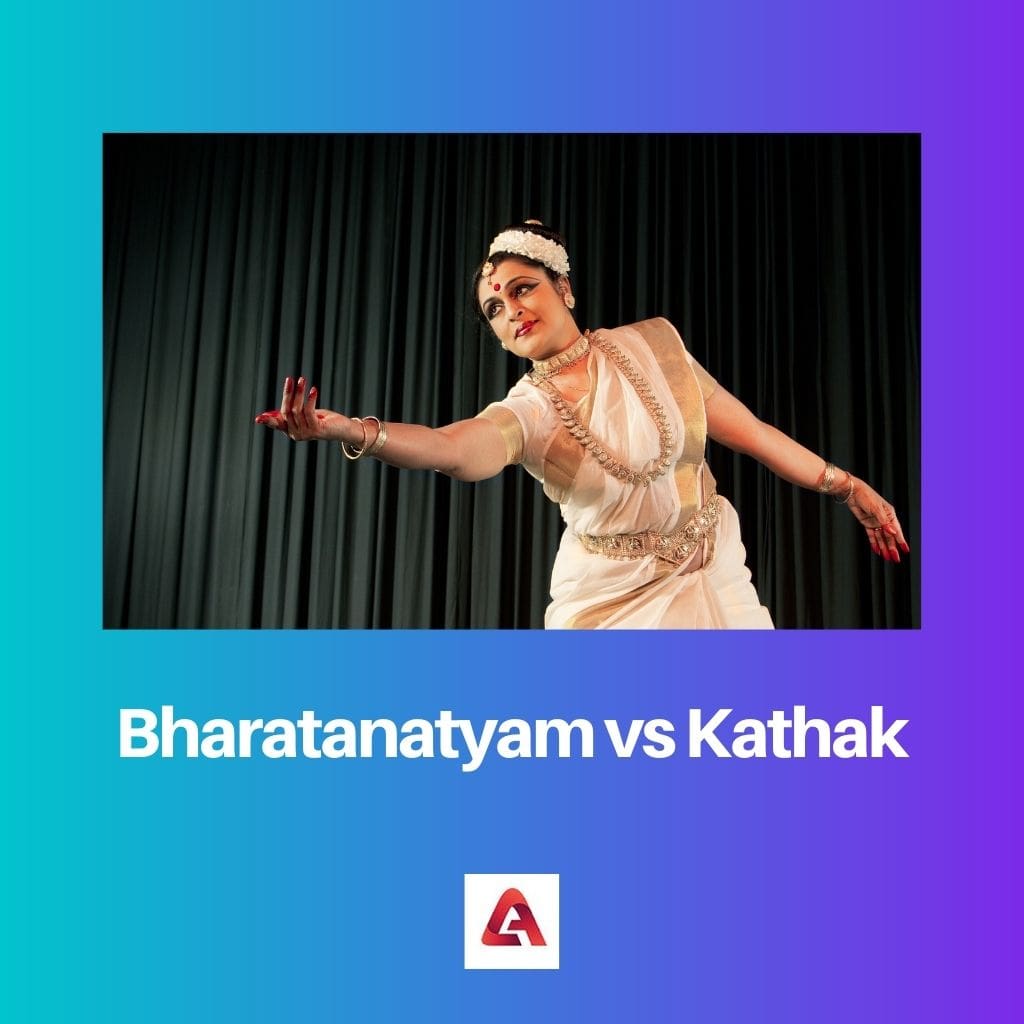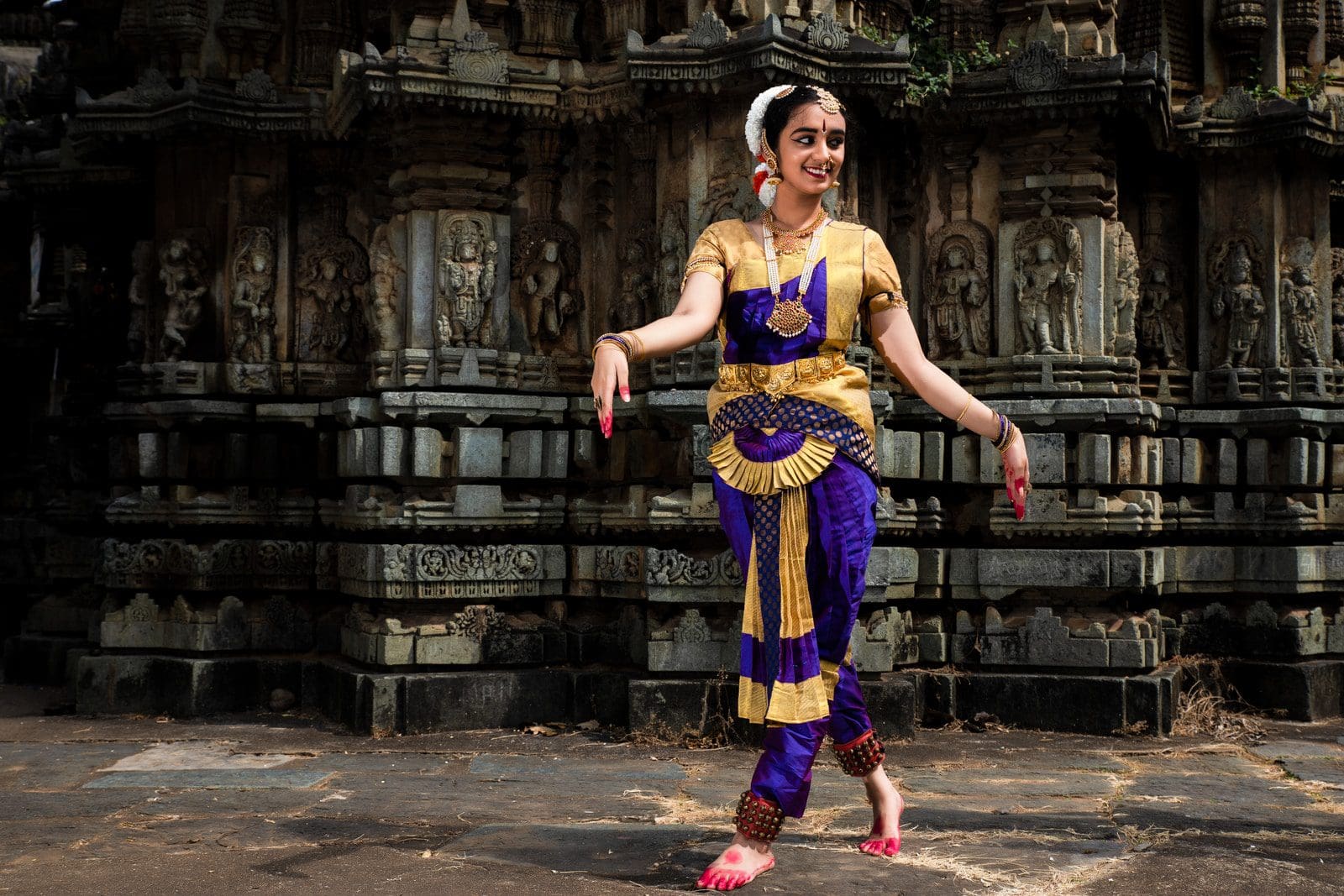Both Bharatanatyam and Kathak are very much different from each other in their meaning and their different characteristics.
Key Takeaways
- Bharatanatyam and Kathak are two different styles of classical Indian dance.
- Bharatanatyam is more formal and structured than Kathak.
- Kathak is more improvisational and focuses on storytelling through dance.
Bharatanatyam vs Kathak
Bharatanatyam is a classical dance belonging to the Tamil Nadu of India, using Carnatic music, expresses stories through complicated footwork and body gestures. Kathak is a classical dance from Rajasthan and Uttar Pradesh using Indian classical music to express stories with hand movements and face expressions.

The word Bha in Bharatanatyam means emotion, also called bhava; RA means music, also called Raaga; Ta means rhythm, also called Taal; and Natyam, which means dance. So the word Bharatanatyam means to dance with rhythm, expression, and music and is strongly related to Natyashastra, which means the scripture of classical Indian dance.
Kathak’s word has its roots in the Vedic Sanskrit word Katha; it also means Kathak and “story,” which means to tell a story. It is also considered one of the forms out of eight significant forms in Indian classical dance.
Comparison Table
| Parameter of Comparison | Bharatanatyam | Kathak |
|---|---|---|
| Meaning | The term Bharatanatyam is a type of classical dance with rhythm, expression, and music. | The word Kathak comes from Vedic Sanskrit Katha, which means story and Kathak. |
| Originated | Bharatanatyam is mainly practiced in southern India. | Kathak is mainly practiced in northern India. |
| Instruments | In the Bharatanatyam dance, the instruments mainly used are mridangam, nagaswaram, and veena. | In Kathak, the instruments mainly used are bansuri, tabla, sarangi, and sarod. |
| Costumes | In Bharatanatyam, dresses and jewelry are very grand and gorgeous. | In Kathak, dresses and jewelry are mainly simple ones. |
| Movement | In the Bharatanatyam dance, there are many hip movements and many mudras. | In Kathak dance, the dancer dances in a standing position throughout; there is no hip movement. |
| Main difference | It is mainly evolved or based on the story of Shiva. | It is mainly evolved or based on the story of lords Radha and Krishna. |
What is Bharatanatyam?
Bharatanatyam is considered an art performed by temple dancers, and Carnatic music is played during the dance. This dance is also performed in the court of the South Indian king.
The dancers use many hip movements and mudras while dancing. Because of the movement, the dancers have used half of the stage space.
The movement which Bharatanatyam dancers perform resembles the movement of fire or flame. Bharatanatyam dance is based or evolved around the stories of Lord Shiva.
It is a dance where dancers have more sitting or bent knee posture dance. The dancers wore unique costumes of different varieties and unique jewelry depending upon the dancers’ performance.
The dresses worn by the dancers do not restrict the movement during the dances. The dresses in the Bharatanatyam are very elegant and grand.
The dancers do heavy makeup and hair so that they look good. Different instruments are played in Bharatanatyam, like mridangam, veena, violin, and nagaswaram.
It is also believed that S. Krishna Iyer created Bharatanatyam in the mid-thirties, which Rukmini Devi Arundale later spread. Bharatanatyam’s history originated in the 2nd century through a text in Natya Shastra and Muni.

What is Kathak?
Kathak is an Indian classical dance performed by dancers in the Muslim king’s court. People used to believe that the Kathak dance tells the story of Rassalila, done by Radha and Krishna in a forest.
In Kathak, the dancing movement is always standing posture throughout the performance. It also has no or limited hip movement in dance.
As Kathak tells the story of Radha and Krishna, people believe that performing the part of Krishna, the dancer sometimes appears dreamy and closes her eyes slightly as they do not make eye contact with anyone. The costumes dancers wear while performing are for women and dhotis for men.
The long skirt and top, also known as lehenga and choli, are worn by the female kathak dancers. During the Mughal period, male Kathak dancers wore kurta churidar with a cap.
Different instruments are also played while dancing, like sarod, sarangi, sitar, bansuri, Hungary, and harmonium. Kathak mainly originated during the bhakti movement.
This classical dance was also traced back to 400 BC, whose earlier sage name was Natya Shastra.

Main Differences Between Bharatanatyam and Kathak
- Both are different types of Indian classical dance performed in other parts of the country.
- Bharatanatyam is mainly practiced in southern India. On the other hand, Kathak is mainly practiced in northern India.
- Bharatanatyam mainly evolved or was based on stories of Shiva. On the other hand, Kathak evolves or is based on Radha and Krishna’s tales or stories.
- In the Bharatanatyam dance, there are many hip movements and many mudras. On the other hand, in kathak dance, the dancer is standing throughout; there is no hip movement.
- In Bharatanatyam, dresses and jewelry are very grand and gorgeous and have a unique style. On the other hand, kathak dresses and jewelry are mainly simple ones. Women wear saree and menswear dhoti while dancing.


The detailed comparison has left me with a newfound appreciation for both Bharatanatyam and Kathak. This article offers a comprehensive understanding of these classical dance forms.
The detailed insights into the significance and origins of Bharatanatyam and Kathak were fascinating. It has truly expanded my understanding of Indian classical dance forms.
I completely agree, Clark! This article is a gem for enthusiasts of Indian dance and culture.
I found the comparison table to be incredibly informative and well-structured, making it easy to comprehend the differences between Bharatanatyam and Kathak.
Absolutely, Ellie. The table was an excellent addition to this informative article.
I couldn’t agree more, Ellie! The details provided in the table were very helpful.
I appreciate the detailed comparison between Bharatanatyam and Kathak, it has really helped me understand the unique characteristics of each dance form.
You are absolutely right, Carter! This article does a great job at explaining the complex differences between the two classical dances.
The attention to detail in describing the intricate movements of both Bharatanatyam and Kathak is truly commendable, making this article a valuable resource for those interested in classical Indian dance.
This article provides an excellent breakdown of the differences between Bharatanatyam and Kathak, catering to both dance enthusiasts and those new to the art forms.
I expected a more in-depth analysis of the cultural and spiritual significance of Bharatanatyam and Kathak. While the technical differences are well-covered, the broader context feels lacking.
The information provided about the origin and meaning of both Bharatanatyam and Kathak were extremely enlightening and educational.
I completely agree, Patel! The depth of understanding provided in this article is truly impressive.
I thought the same, Patel. This article really does justice to the complexity of these dance forms.
The thorough explanation of the intricate movements and styles of Bharatanatyam and Kathak was exceptional, providing valuable knowledge for dance enthusiasts.
You’re absolutely right, Hughes! The depth of insight in this article is commendable.
I wish the article delved deeper into the historical and cultural significance of both dance forms rather than just focusing on their technical differences.
I see where you’re coming from, Qrichardson. It’s important to appreciate the broader context of these classical dances.
I understand your point, Qrichardson. It would have added more depth to the article.